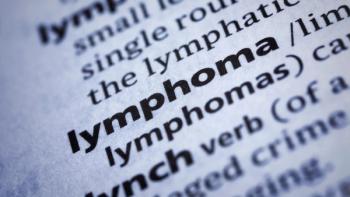
Two Are Better Than One: Alternating Chemoimmunotherapy Regimens May Benefit Those with MCL
A recent study looked at a new combination to determine what would happen if untreated patients eligible for transplant were given alternating cycles of Rituxan plus bendamustine and Rituxan plus cytarabine as induction therapy. The study pooled findings from two clinical trials and real-world experience.
Induction therapy using Rituxan (rituximab) in combination with an alternation of bendamustine and cytarabine before stem cell transplantation prolonged survival outcomes among untreated, transplant eligible patients with mantle cell lymphoma, according to pooled analysis data presented at the 2018 American Society of Hematology (ASH) Annual Meeting, held Dec. 1 to 4 in San Diego.
For untreated patients with mantle cell lymphoma, stem cell transplant using their own cells (autologous) is standard of care. Those eligible must prepare by undergoing induction chemotherapy, but there is debate about which drugs are the most effective. The targeted drug Rituxan is used in this setting, and is paired with chemotherapies: bendamustine, a cocktail called CHOP or a different cocktail known as Hyper-CVAD, which includes cytarabine.
A recent study looked at a new combination of some of these drugs to determine what would happen if untreated patients eligible for transplant were given alternating cycles of Rituxan plus bendamustine and Rituxan plus cytarabine as induction therapy. The study pooled findings from two clinical trials and real-world experience.
Previous trials demonstrated that Rituxan plus Bendamustine induced longer progression-free survival (the amount of time without disease progression) compared with Rituxan paired with CHOP; while, the addition of Rituxan and cytarabine to CHOP also reduced patients’ risk for disease progression.
Therefore, lead study author Reid Merryman, M.D., and colleagues hypothesized that an induction regimen including Rituxan, bendamustine and cytarabine, followed by autologous transplant, would improve outcomes in previously untreated patients with advanced mantle cell lymphoma.
A phase 2 clinical trial was set up at the Dana-Farber Cancer Institute in Boston to test alternating cycles of Rituxan/bendamustine and Rituxan/cytarabine in this population of patients. In the trial, patients went on to transplant after the induction therapy.
The trial was conducted in 23 patients who were enrolled from 2012 to 2014. The overall response rate (the percentage of patients with reduction in tumor size of a predetermined amount) and complete response rate (the percentage with no signs of cancer after treatment) were the same, at 96 percent. After 13 months of follow-up, progression-free survival was also 96 percent. Based on these results, alternating cycles of Rituxan/bendamustine and Rituxan/cytarabine became the standard of care for patients in this population at Dana-Farber.
Researchers at the institution then tracked results of the induction regimen by looking at the records of 49 patients treated outside their study, in both academic and community centers, from 2014 through 2018. Meanwhile, a second phase 2 study of the regimen in 14 patients was set up at Washington University in St. Louis, enrolling from 2016 to 2018. The goals of these efforts were to determine long-term outcomes of this therapy, as well as efficacy and safety, in a larger cohort and outside a clinical trial.
At Dana-Farber, patients were given three courses of Rituxan/bendamustine and then three courses of Rituxan/cytarabine. At Washington University, they got three courses of each, but in an alternating pattern. Patients in the studies were a median 57 years of age and in good health besides their cancer. Seventy-two percent of them were male. Across all the study settings, most patients had stage 4 disease.
Ninety-four percent of patients completed their induction treatment. At the end of induction, across all the study settings, the patients had a 98 percent overall response rate and a 92 percent complete response rate.
Five patients discontinued therapy: three due to persistent cytopenias (low numbers of blood cells) during Rituxan/cytarabine treatment, one due to rash associated with Bendamustine and one due to progressive disease.
Serious and severe hematologic side effects were common in patients who participated in the two clinical trials, especially during therapy with Rituxan/cytarabine: lymphopenia (a low number of white blood cells called lymphocytes; 92 percent), thrombocytopenia (low platelet count; 81 percent), leukopenia (a drop in the number of white blood cells called leukocytes; 78 percent), neutropenia (a low number of white blood cells known as neutrophils; 76 percent) and anemia (a low count of red blood cells; 41 percent). Non-hematologic side effects, such as fever, pneumonia and bacteremia (bacteria in the blood), were rare. Given the association between cytarabine and these side effects, the researchers looked at dosing in the trial and determined that progression-free survival was similar for patients who took lower versus higher doses of the chemotherapy, said Merryman, who is a resident at Dana-Farber.
Of 86 patients studied, 77 went on to get transplants after induction therapy. Three were observed and three were given maintenance treatments with Rituxan, due to persistent cytopenias, inadequate stem cell collection and other reasons. Two patients with progressive disease were given alternate treatments, as was one patient who had a partial response after induction.
After transplant, one patient died from respiratory failure and respiratory syncytial virus infection, and about one-quarter of patients, at both day 30 and day 100, experienced delays in the ability of their transplanted cells to grow and make healthy cells. Most of the patients who experienced this had taken Rituxan/bendamustine and Rituxan/cytarabine on an alternating schedule rather than a sequential one, and this challenge was also associated with taking higher doses of cytarabine.
Across the study settings, progression-free survival was 85 percent at three years and 80 percent at five years. Overall survival was 92 percent at three years and 85 percent at five years.
Researchers found some characteristics associated with a worse progression-free survival: a high MIPI (mantle cell lymphoma international prognostic index) score in 15 percent of patients across all three study settings; blastoid or pleomorphic disease subtype in 14 percent of patients; and ki67, a protein involved in cell growth, present in amounts higher than 30 percent in 26 percent of patients tested.
In one subset of patients, the researchers tracked blood for the appearance of detectable tumor DNA and found that this may be a good way to predict relapse after treatment. Blood was tested for circulating tumor cells, repeatedly over time, using immunoglobulin-based next-generation sequencing, Merryman said.
Based on all these results, the researchers recommended using this new regimen in eligible patients.
“Our analysis suggests this regimen can be used outside of a clinical trial with favorable outcomes in both academic and community settings,” Merryman said.
Alternating Rituxan/bendamustine and Rituxan/cytarabine may be “an excellent choice of induction therapy for transplant-eligible patients with untreated mantle cell lymphoma, and could be further tested in comparative prospective trials,” the researchers wrote in their abstract. “Sequential, rather than alternating…cycles and lower-dose cytarabine may reduce the risk of prolonged thrombocytopenia post-(transplant).”




